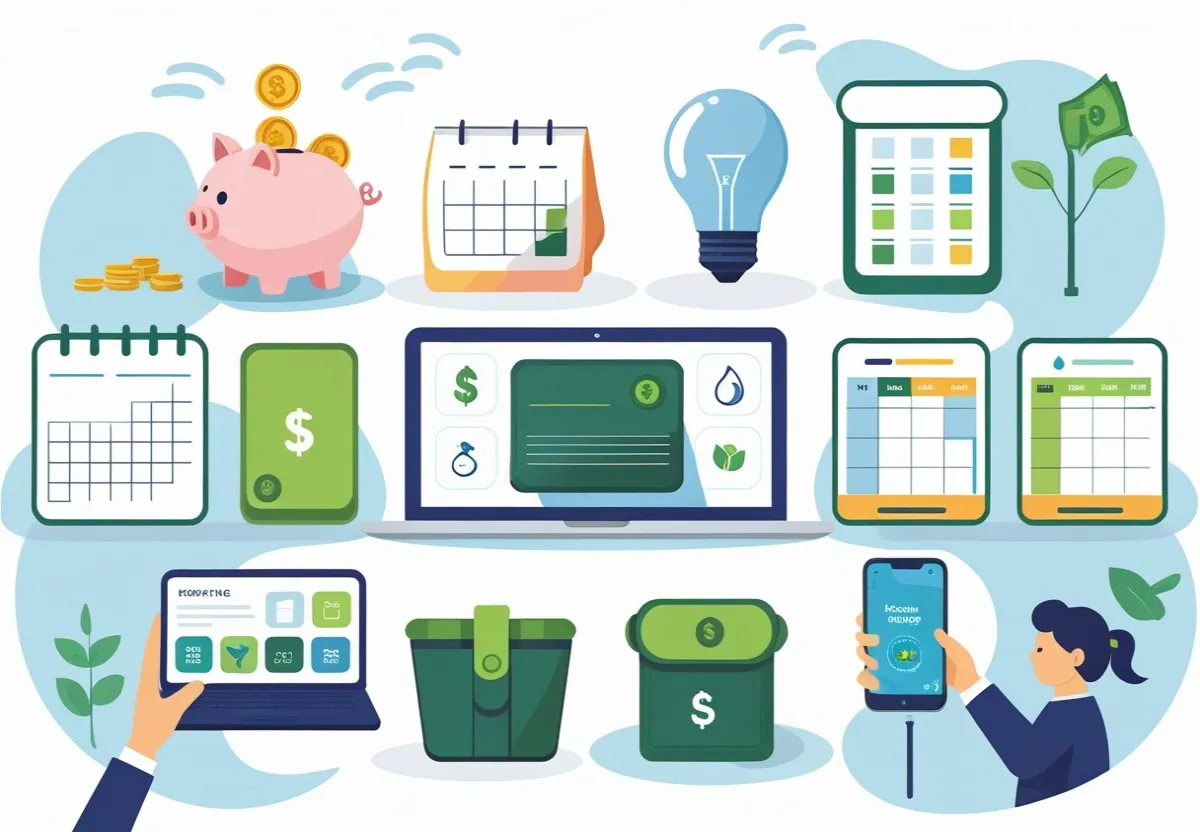Smart shopping can help anyone save a significant amount of money each month without sacrificing quality or convenience. By using simple strategies like meal planning, buying in bulk, and avoiding impulse purchases, shoppers can cut their spending by hundreds of dollars. The key is making intentional choices that stretch every dollar further and reduce waste.

Many people end up overpaying because they don’t plan or use available tools to compare prices. Smart shoppers use apps, coupons, and timing to get the best deals. With rising costs, these habits become even more important to maintain a balanced budget while still enjoying favorite products.
Adopting a few practical shopping habits leads to steady savings over time. Anyone can improve their grocery budget and everyday spending by learning and applying these straightforward methods.
Building a Smart Shopping Foundation

A strong foundation for smart shopping starts with clear money goals, understanding why spending happens, and keeping track of every expense. These elements help shoppers save money consistently and avoid unnecessary purchases.
Setting Realistic Monthly Savings Goals
Setting a clear and realistic savings goal each month guides smarter shopping decisions. Instead of vague aims like "save more," shoppers should pick a specific amount to save. This helps focus on cutting spending in areas where money leaks the most.
Goals should match income and essential expenses. For example, saving $100 monthly might require reducing dining out or impulse buys. Breaking goals down weekly can make them easier to follow.
Goals work best when written down or tracked with apps. Reviewing progress regularly lets shoppers adjust habits or targets if needed. Clear goals keep commitment strong and spending habits on track.
Understanding Your Spending Triggers
Knowing what causes overspending is key to saving money. Triggers can be emotional, like stress or boredom, or situational, like sales alerts or social pressure. Identifying these helps shoppers avoid unnecessary purchases.
Common triggers include shopping to feel better, ads that create urgency, or friends influencing buying choices. Recognizing these allows shoppers to pause and ask if the purchase is needed.
Creating a plan to manage triggers may involve setting rules like no online buying after 8 PM or unsubscribing from marketing emails. Awareness reduces wasted money and builds stronger control over spending.
Tracking Expenses for Better Budgeting
Accurate tracking of expenses helps shoppers see where money is actually going. This clears up false assumptions and highlights areas for improvement. Tracking can be done with notebooks, spreadsheets, or budgeting apps.
Shoppers should record every purchase, even small ones like coffee or snacks. Over a month, patterns emerge that show avoidable spending or chances to save.
Analyzing tracked expenses helps create a practical budget. A budget limits spending in non-essential categories, ensuring more money goes toward savings. Tracking turns goals into achievable action steps by providing clear numbers.
Mastering the Shopping List

A well-crafted shopping list helps shoppers avoid overspending and waste. It organizes needs clearly, supports planning, and limits impulse purchases. The right list can save time and money by focusing on essentials and preventing unplanned buys.
Creating an Effective Shopping List
An effective shopping list includes items based on actual needs, not impulse or habit. Shoppers should check their pantry, fridge, and freezer before writing it down.
Grouping items by category, such as produce, dairy, or canned goods, makes shopping quicker and less confusing. Using apps or notes on a phone can keep the list accessible and editable.
Keeping the list realistic and specific helps avoid vague reminders like “milk” when the needed amount and type (“1 gallon skim milk”) are clearer. This reduces mistakes at the store and minimizes unnecessary purchases.
Planning Purchases in Advance
Planning purchases in advance helps spread out spending and avoid last-minute buys that inflate grocery bills. Reviewing weekly meals before shopping keeps the list focused and reduces food waste.
Bulk or sale items should fit into the plan only if they will be used soon. Planning also means noting expiration dates and combining meals to use ingredients fully.
By setting aside time each week to update the shopping list based on meal plans, preferences, and household needs, shoppers prevent poor choices and control food costs.
Sticking to Essentials to Avoid Impulse Buys
Sticking to essentials on the list helps avoid impulse buys that quickly add to the total cost. Shoppers who feel confident about their list are less likely to be swayed by sales or extra items at checkout.
It is useful to use cash rather than card, or leave extra cards at home to limit spending flexibility. Avoiding grocery trips when hungry or tired also reduces impulse purchases.
Keeping the list short and focused on necessary and planned items improves discipline. Impulse buys often include unhealthy snacks or non-essential products that break budgets and meal planning.
Maximizing Cashback and Reward Programs
Using cashback apps, online portals, and store loyalty programs can add up to significant savings. Combining these tools requires attention to detail and knowing how each one works best. Effective use of these programs means careful planning and stacking rewards when possible.
Leveraging Ibotta for Grocery Savings
Ibotta is a popular cashback app focused on groceries. Shoppers can earn cashback by uploading receipts or linking store loyalty cards directly to the app. Before shopping, users should browse Ibotta’s offers carefully and select rebates for the products they plan to buy.
Shopping at participating stores helps maximize earnings. Many offers include brand-specific items or general categories like dairy or produce. Additionally, Ibotta often provides bonuses when users hit certain goals, such as redeeming a set number of offers in one week.
To increase savings, combining Ibotta with store loyalty discounts or coupons is useful. This approach helps shoppers get immediate discounts at checkout and cashback afterward, stacking savings on the same purchases.
Optimizing Rakuten for Online Shopping
Rakuten is an online cashback portal that rewards users for shopping through its links on a wide range of retailers. Shoppers start by visiting Rakuten’s site, searching for their favorite store, and clicking through before making a purchase.
Rakuten tracks the purchase and credits cashback, typically within a few days. It also offers periodic bonus events and referral rewards that increase income from everyday shopping.
Using browser extensions for Rakuten can simplify the process by notifying users of cashback opportunities in real time. Combining Rakuten with credit card reward programs can further boost the total savings.
Utilizing Store Rewards and Loyalty Points
Many retailers offer their own rewards or loyalty points programs that provide discounts, free items, or special offers. Signing up for these programs is often free and can lead to consistent savings on repeat purchases.
Users should focus on stores they frequent most. Tracking points or rewards earned and redeemed helps avoid expiration and maximizes benefits.
Some programs offer perks beyond points, like early access to sales or personalized coupons. Combining these perks with other cashback programs can yield bigger overall savings.
Smart Price Comparison Tactics
Smart price comparison helps shoppers find the best deals without wasting time or money. Knowing where and when to look for prices can make a big difference in savings. Using technology and understanding timing are key to stretching your budget.
Using Price Comparison Apps
Price comparison apps gather prices from many stores quickly. They let shoppers see which store offers the lowest cost for the same product. This saves time from checking multiple websites or stores individually.
Many apps also show unit prices, so users know exactly how much they pay per item weight or volume. This helps compare deals on products sold in different sizes.
Some apps offer alerts when prices drop or when coupons become available. This helps shoppers buy only when the best deal appears.
Timing Purchases for Seasonal Discounts
Buying at the right time can lower costs significantly. Many products go on sale during specific seasons or holidays, like winter clothing at the end of the season.
Shoppers should track price patterns for the items they buy often. For example, electronics usually cost less during big sale events like Black Friday or back-to-school periods.
Planning purchases around these cycles ensures shoppers get discounts without paying full price. Combining this with price comparison increases savings even more.
Strategic Budgeting for Everyday Shopping
Setting clear limits for monthly spending helps shoppers control their expenses and avoid impulse buys. Tracking where money goes, especially on non-essential items, reveals opportunities to cut back and save money over time.
Setting Monthly Shopping Budgets
A well-planned monthly shopping budget starts by listing all necessary items, such as groceries, household supplies, and personal care products. Shoppers should allocate a specific dollar amount for each category based on past spending and current needs.
Using a budget tracking app or a simple spreadsheet helps monitor spending in real time. This practice ensures they stay within limits and avoid overspending.
It’s important to review and adjust the budget every month, factoring in seasonal price changes or sales. Automated alerts can remind shoppers when they are close to reaching their budget, helping them make smarter choices.
Tracking Spending on Non-Essentials
Non-essential purchases like snacks, drinks, or extras can quietly reduce overall savings. Keeping a detailed record of these expenses can reveal patterns of unnecessary spending.
One effective method is to separate payments for essentials and non-essentials, using different cards or cash envelopes. This makes it easier to see how much goes to non-essentials each month.
By reviewing this information regularly, shoppers can reduce impulse buys and redirect that money toward more important purchases, significantly increasing savings without impacting daily quality of life.
Avoiding Common Shopping Pitfalls
Smart shoppers watch out for traps that lead to wasted money. They stay aware of their feelings during shopping and carefully check if discounts are real or just marketing tricks.
Dodging Emotional and Impulse Purchases
Shoppers often buy things because they feel excited, stressed, or want a quick reward. These emotional buys add up and hurt the budget. To avoid this, it helps to create a clear list before shopping and stick to it.
Waiting 24 hours before buying something unplanned can reduce impulse purchases. Shoppers should ask themselves if the item is really needed or if they just want it briefly.
Apps for budgeting and tracking spending also keep emotions in check by showing where money goes. This helps shoppers make calm, informed choices instead of reacting to feelings.
Recognizing Misleading Discounts
Many sales use tricks that seem like a great deal but aren't. For example, "original prices" can be inflated to make discounts look bigger.
Smart shoppers compare prices across stores and online before buying. They also check unit prices (cost per ounce, pound, or item) to see if the deal is truly cheaper.
Sometimes “buy one get one free” deals push shoppers to buy more than needed. Shoppers should calculate the cost per unit to know if those offers save money or just increase spending.
Being suspicious of countdown timers or “limited-time offers” helps, because these create false urgency. Taking time to research stops rushed decisions caused by clever marketing.
Optimizing Savings on Major and Recurring Expenses
Smart shoppers focus on cutting costs where they spend the most. This means carefully managing regular bills and making good choices on bigger purchases. These steps can lead to substantial savings every month.
Reducing Subscription and Utility Costs
Many people overlook how much their subscriptions add up. Canceling unused services or switching to cheaper plans can instantly save money. Comparing options before renewing subscriptions is essential.
Utility bills can also be lowered by using energy-efficient appliances and adjusting daily habits. Simple actions like turning off lights, reducing water use, and setting thermostats wisely cut costs without much effort. Checking for special utility rate plans or seasonal discounts can further reduce expenses.
Tracking monthly usage helps spot wasteful patterns. Small changes in subscriptions and utilities add up quickly, giving more money back each month.
Buying Quality Second-Hand and Discounted Items
Purchasing second-hand items is a smart way to save money on many products. Quality used goods, like furniture, tools, or electronics, often last long but cost much less than new ones. Shoppers should research and inspect items carefully to avoid defects.
Discounted products, including clearance or open-box sales, are also valuable. These items are often new or nearly new but sold at lower prices due to packaging damage or overstock.
Tips for success:
- Use trusted resale websites or local thrift stores
- Check return policies on discounted items
- Prioritize buying from reputable sellers
- Focus on purchases where quality matters most
Choosing second-hand or discounted goods reduces expenses while maintaining quality, helping to stretch the budget further.
Sustaining Long-Term Savings with Smart Habits
Smart shopping is not just about one-time deals. It requires ongoing effort to keep saving money every month. Staying aware of spending habits and tracking savings goals helps maintain strong financial habits over time.
Regularly Reviewing Shopping Strategies
He or she should check their shopping methods often. This means looking back at what is working and what is not. For example, comparing prices, trying new stores, or shifting when to buy certain items can affect how much money is saved.
Adjusting plans is important. If sales change or new discounts appear, updating strategies can add savings. Making a habit of reviewing receipts or tracking spending weekly helps catch mistakes or unnecessary buys. It also keeps the focus on smart spending instead of impulse purchases.
It can help to create a simple checklist, like:
- Check weekly sales and promotions
- Compare prices online and in-store
- Prioritize buying in bulk when it saves money
- Avoid buying items full price without reason
Regular reviews turn saving money into a steady, manageable habit.
Tracking Progress Toward Savings Milestones
Tracking how much money is saved helps keep motivation high. Setting clear targets, like saving $100 or $200 each month, makes it easier to measure progress.
Using tools like simple spreadsheets or budgeting apps helps monitor spending and savings over time. Tracking also shows where cuts or improvements are possible.
Breaking goals into milestones, such as saving $50 every two weeks, provides clear steps. It creates a sense of achievement and reinforces the habit.
A basic tracking table can include:
| Date | Savings Target | Actual Saved | Notes |
|---|---|---|---|
| July 1–15 | $50 | $60 | Found extra coupon |
| July 16–31 | $50 | $45 | Skipped impulse buys |
This method ensures steady progress and makes saving money a clear, ongoing priority.

















